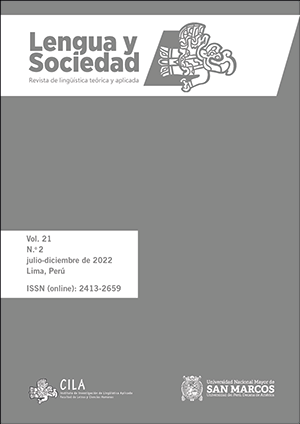The topography of sarcasm: a cognitive approach
DOI:
https://doi.org/10.15381/lengsoc.v21i2.22759Keywords:
Sarcasm, irony, topography, cognition, victimizing effectAbstract
The purpose of this paper is to provide a difference between irony and sarcasm in the framework of cognitive pragmatics. We consider that the rise of the pragmatic turn allows us to understand the enrichment of what has been said, according to Recanati’s point of view (2003). However, the phenomenological level of what has been said has to be anchored at a deeper level: the conceptual structure. We postulate that, to the extent that sarcasm is linked to a victimizing effect, there are layers (Coulson, 2005) that allow the emergence of sarcastic interpretation. In irony, such a victimizing effect is not a necessary condition (Kreuz 2020). In order to visualize the topography of sarcasm, we develop an analysis method based on a tetraspatial model: a generic space, two input spaces and a blended space (Fauconnier & Turner, 2002). It is in the blend where the sarcastic meaning arises because there the victimizing effect of the mocking expressions is reflected.
References
Albaladejo, T. (1991). Retórica. Síntesis.
Bach, K. (2001). You don’t say? Synthese, 128(1,2), 15-44.
Cann, R. (1993). Formal semantics. Cambridge University Press.
Casas, R. (2019). Ironía y cognición. Mantaro.
Casas, R. (2021). En torno al efecto Baldwin: evolución y lenguaje. Lengua y Sociedad, 20(1), 287-314. https://doi.org/10.15381/lengsoc.v20i1.22281
Cheang, H. & Pell, M. (2008). The sound of sarcasm. Speech Communication, 50, 366-381.
Clark, H. (1996). Using language. Cambridge University Press.
Coulson, S. (2005). Sarcasm and the space structuring model. En Coulson, S. & Lewandowska-Tomasczyk (eds.), The literal and the nonliteral in language and thought. Lang; 129-144.
Culicover, P. & Jackendoff, R. (2005). Simpler Syntax. Oxford University Press.
Evans, V. & Green, M. (2018). Cognitive Linguistics. Taylor and Francis.
Fauconnier, G. (1986). Espaces mentaux. Aspects de la construction du sens dans les langues naturelles. Minuit.
Fauconnier, G. & Turner, M. (1998). Conceptual integration networks. Cognitive Science, 22(2), 133-187.
Fauconnier, G. & Turner, M. (2002). The Way We Think: Conceptual Blending and the Mind’s Hidden Complexities. Basic Books.
Geeraerts, D. (1997). Diachronic Prototype Semantics. Clarendon Press.
Gibbs, R. (1994). The poetics of mind. Figurative thought, language, and understanding. Cambridge University Press.
Hayakawa, S. (1967). El lenguaje en el pensamiento y en la acción. UTEHA.
Huang, Y. (2015). Pragmatics. Oxford University Press.
Jankélévitch, V. (2012). La ironía. Taurus.
Kapogianni, E. (2016). The ironic operation. Journal of Pragmatics, 91, 16-28.
Kierkegaard, S. (2000). Sobre el concepto de ironía en constante referencia a Sócrates. Trotta.
Kissine, M. & Pantazi, M. (2017). Pragmatic accommodation. En Gutzmann, D., Matthewson, L., Meier, C., Hotze, R. & Zimmerman, T. (eds.). The Wiley Blackwell Companion to Semantics (pp. 1-16).
Kreuz, R. (2020). Irony and Sarcasm. The MIT Press.
Lovón, M. A., Montenegro, M. I., & Chegne, A. D. (2021). La COVID-19 y la metáfora bélica: un análisis cognitivo en los diarios digitales y las redes sociales. Boletín de la Academia Peruana de la Lengua, 70(70), 155-196. https://doi.org/10.46744/bapl.202102.005
Moliner, M. (1966). Diccionario de uso del español. Gredos.
Muecke, D. (1982). Irony and the ironic. Methuen.
Recanati, F. (2002). Unarticulated constituents. Linguistics and Philosophy, 25, 299-345.
Recanati, F. (2003). Literal Meaning. Cambridge University Press.
Schoentjes, P. (2001). La poética de la ironía. Cátedra.
Vargas Llosa, M. (1999). Los pies de Fataumata. El País (25 de julio de 1999). https://elpais.com > Opinión
Downloads
Published
Issue
Section
License
Copyright (c) 2022 Raymundo Casas Navarro

This work is licensed under a Creative Commons Attribution 4.0 International License.
AUTHORS RETAIN THEIR RIGHTS
a. Authors retain their trade mark rights and patent, and also on any process or procedure described in the article.
b. Authors can submit to the journal Lengua y Sociedad, papers disseminated as pre-print in repositories. This should be made known in the cover letter.
c. Authors retain their right to share, copy, distribute, perform and publicly communicate their article (eg, to place their article in an institutional repository or publish it in a book), with an acknowledgment of its initial publication in the journal Lengua y Sociedad.
d. Authors retain theirs right to make a subsequent publication of their work, to use the article or any part thereof (eg a compilation of his papers, lecture notes, thesis, or a book), always indicating its initial publication in the journal Lengua y Sociedad (the originator of the work, journal, volume, number and date).






